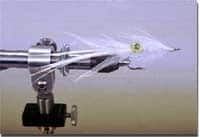
Lead Eyes Squid
Squid is one of the main food sources for higher species of fish in all of earth’s oceans. Notwithstanding, nearly all gamefish such as tunas, marlins, sharks, and smaller species will pursue and feed on squid before all other food sources. While operating the charterboat, Dolphin Too, out of Ocean City, Maryland, during the 80’s and 90’s, it was not uncommon for us to catch both Bluefin, and Yellowfin Tuna during the offshore trip. Interestingly, I began to examine the stomach contents while cleaning the tuna back at the dock and almost always found fresh squid, lined up in a row. In fact, the squid was so fresh, we would rig it for the next day’s trolling. The point here is squid is a constant food source for these fish. Many squid flies I have used in recent years look good, but never seem to emulate the swimming nature of the squid. The squid propels itself through the water by fi’ling the folds in it’s body walls with water and forcing it through a tube or funnel which lies bneah the head. The ‘jet’ action makes the animal move. The head of the squid is surrounded by ten arms, two of which are longer then the others, and seem to oscillate from it’s swimming action. It is that motion which is important when designing and fishing a squid fly. The squid is dark grey but can change color to blend with the environment. The eyes are well-developed and are extremely visible. Nearly two years ago, I started fishing with Captain Tim Tanis in Ocean City, Maryland, who was concentrating on offshore fly fishing for tunas, bluefish, and other gamefish. He also owned Lead Eyes Fly Company and was tieing an assortment of flies for local fishing supply stores. While on one of those trips in the Summer of 98, Tim pulled out a new fly he had just developed, and succeeded to outfish me all day. Both of us were using 9 weight rods with Cortland sinking line. We were catching an assortment of bluefish and dolphin. While the bluefish were chewing on the fly, it continued to fish, minus a couple of the feathers. I also noticed he was fishing the fly with a long stripping motion, and pull on the fly rod to produce the propulsion of a squid. As he was fishing the fly, the feathers seemed to be alive in the water. At the end of the day, Tim gave me one of the flies he had successfully fished through most of the day. A closer look at the fly confirmed my speculation about it being a new squid pattern which I had not seen. The fly did not look complicated, with feathers at two different lengths, some bucktail, chenille, flash, and eyes. It was cream colored, tied on a 3/0 hook. Tim says the fly is not complicated, nor takes long to tie, however, a two step epoxy process drives up the time. Compared to other squid flies I have seen, this is a fly that the saltwater fly fisherman will tie. Before this fly was offered to the public, Tim wanted to continue to test it through the summer. He asked me not to talk or write about it until he was sure it worked. Through all of the 98 fishing season, the fly was tested including inland species such as Rockfish, Sea Trout, and Flounder. Tim was even amazed how well the fly tested. All he did was vary the size and add colors to the original pattern. At a recent fly fishing show in Baltimore, Tim says its time to get this fly out to the public. He had fished it all during the 99 season, with incredible success. The fly which was first developed in 98, and proven during the 99 season, now had a name-Lead Eyes Squid Fly. To improve the efficiency of this fly, you need to think like a squid. Long, quick strips will cause the feathers to oscillate back and forth. Remember, the squid moves in a quick, thrusting motion, however, as quick as it moves, it is no match for the offshore gamefish. Many times, the failure of a fly is not the fault of the fly, but how it is presented. A wire tippett can be added to the fly when fishing for toothy creatures. I prefer to tie the fly directly on four feet of twenty pound leader material utilizing a Palomar knott. Capt. Tim Tanis is a master fly tier and offers all kinds of saltwater flies for sale through his Lead Eyes Fish Company. He says to remember to sharpen your hooks and contact him if you are having any problems tieing or fishing the squid fly.









